
AZ-102 Free Practice Questions for Microsoft certification, Real Success Guaranteed with Updated AZ-102 Dumps Questions. 100% PASS AZ-102 Microsoft Azure Administrator Certification Transition exam Today!
Free AZ-102 Demo Online For Microsoft Certifitcation:
NEW QUESTION 1
You have an Azure Service Bus.
You need to implement a Service Bus queue that guarantees first in first-out (FIFO) delivery of messages.
What should you do?
Answer: E
Explanation: Through the use of messaging sessions you can guarantee ordering of messages, that is first-in-firstout (FIFO) delivery of messages.
References:
https://docs.microsoft.com/en-us/azure/service-bus-messaging/service-bus-azure-and-service-busqueues- compared-contrasted
NEW QUESTION 2
Note: This question is part of a series of questions that present the same scenario goals. Some question sets might have more than one correct solution, while others
ion in the series contains a unique solution that might meet the stated not have a correct solution. After you answer a question in this section, you will NOT be able to return to it. As a result, these questions will not appear in the review screen.
You have an Azure web app named Appl. App1 runs in an Azure App Service plan named Plan1. Plan1 is associated to the Free pricing tier.
You discover that App1 stops each day after running continuously for 60 minutes. You need to ensure that App1 can run continuously for the entire day.
Solution: You add a triggered WebJob to App1. Does this meet the goal?
Answer: B
Explanation: You need to change to Basic pricing Tier.
Note: The Free Tier provides 60 CPU minutes / day. This explains why App1 is stops. The Basic tier has no such cap.
References:
https://azure.microsoft.com/en-us/pricing/details/app-service/windows/
NEW QUESTION 3
Note: This questions is part of a series of questions that present the same scenario. Each question in the series contains a unique solution that might meet the stated goals. Some question sets might have more than one correct solution, while others might not have a correct solution.
After you answer a question in this section, you will NOT be able to return to it. As a result, these questions will not appear in the review screen.
You have an Azure subscription named Subscription1. Subscription1 contains a resource group named RG1. RG1 contains resources that were deployed by using templates.
You need to view the date and time when the resources were created in RG1.
Solution: From the Subscriptions blade, you select the subscription, and then click Programmatic deployment.
Does this meet the goal?
Answer: B
NEW QUESTION 4
You have an Azure subscription.
You plan to use Azure Resource Manager templates to deploy 50 Azure virtual machines that will be part of the same availability set.
You need to ensure that as many virtual machines as possible are available if the fabric fails or during servicing.
How should you configure the template? To answer, select the appropriate options in the answer area.
NOTE: Each correct selection is worth one point.
Select two alternatives below.
Answer: CG
Explanation: Use two fault domains.
2 or 3 is max, depending on which region you are in. Use 20 for platformUpdateDomainCount
Increasing the update domain (platformUpdateDomainCount) helps with capacity and availability planning when the platform reboots nodes. A higher number for the pool (20 is max) means that fewer of their nodes in any given availability set would be rebooted at once.
References:
https://www.itprotoday.com/microsoft-azure/check-if-azure-region-supports-2-or-3-fault-domainsmanaged- disks
https://github.com/Azure/acs-engine/issues/1030
NEW QUESTION 5
Which blade should you instruct the finance department auditors to use?
Answer: D
Explanation: You can opt in and configure additional recipients to receive your Azure invoice in an email. This feature may not be available for certain subscriptions such as support offers, Enterprise Agreements, or Azure in Open.
Select your subscription from the Subscriptions page. Opt-in for each subscription you own. Click Invoices then Email my invoice.
Click Opt in and accept the terms.
Scenario: During the testing phase, auditors in the finance department must be able to review all Azure costs from the past week.
References: https://docs.microsoft.com/en-us/azure/billing/billing-download-azure-invoice-dailyusage- date
NEW QUESTION 6
You have an Azure subscription named Subscription1. Subscription1 contains a virtual machine named VM1.
You have a computer named Computer1 that runs Windows 10. Computer1 is connected to the Internet.
You add a network interface named Interface1 to VM1 as shown in the exhibit (Click the Exhibit button.)
From Computer1, you attempt to connect to VM1 by using Remote Desktop, but the connection fails. You need to establish a Remote Desktop connection to VM1.
What should you do first?
Answer: A
Explanation: Incorrect Answers:
B: The network interface has already been added to VM. C: The Outbound rules are fine.
D: The inbound rules are fine. Port 3389 is used for Remote Desktop.
Note: Rules are processed in priority order, with lower numbers processed before higher numbers, because lower numbers have higher priority. Once traffic matches a rule, processing stops. As a result, any rules that exist with lower priorities (higher numbers) that have the same attributes as rules with higher priorities are not processed.
References: https://docs.microsoft.com/en-us/azure/virtual-network/security-overview
NEW QUESTION 7
You need to recommend an identify solution that meets the technical requirements. What should you recommend?
Answer: A
Explanation: Active Directory Federation Services is a feature and web service in the Windows Server Operating System that allows sharing of identity information outside a company’s network.
Scenario: Technical Requirements include:
Prevent user passwords or hashes of passwords from being stored in Azure.
References: https://www.sherweb.com/blog/active-directory-federation-services/
NEW QUESTION 8
HOT SPOT
You have an Azure Active Directory (Azure AD) tenant that contains three global administrators named Admin1, Admin2, and Admin3.
The tenant is associated to an Azure subscription. Access control for the subscription is configured as shown in the Access control exhibit. (Click the Exhibit tab.)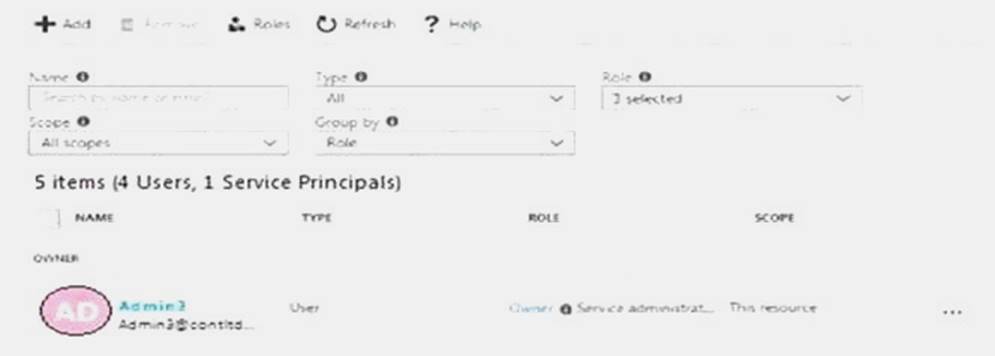
You sign in to the Azure portal as Admin1 and configure the tenant as shown in the Tenant exhibit. (Click the Exhibit tab.)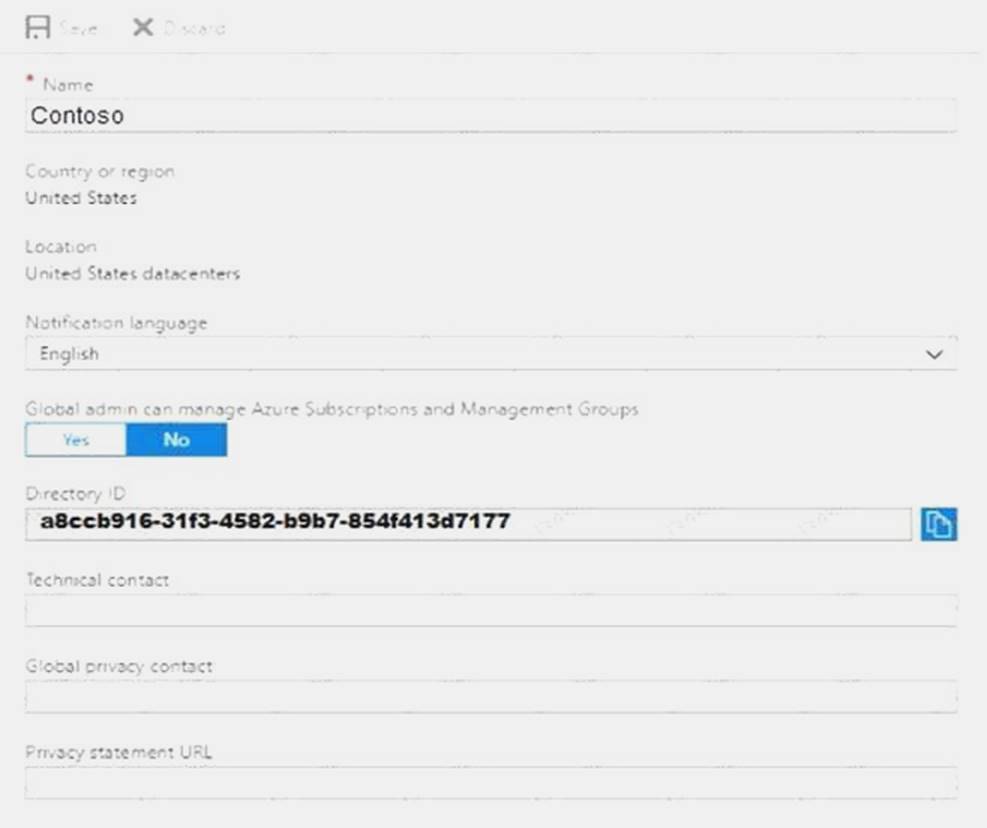
For each of the following statements, select Yes if the statement is true. Otherwise, select No. NOTE: Each correct selection is worth one point.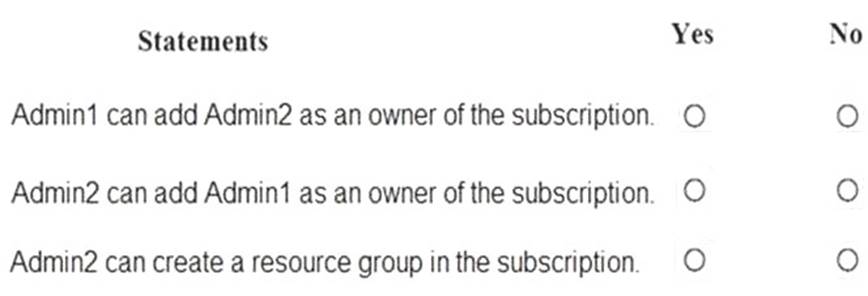
Answer:
Explanation: 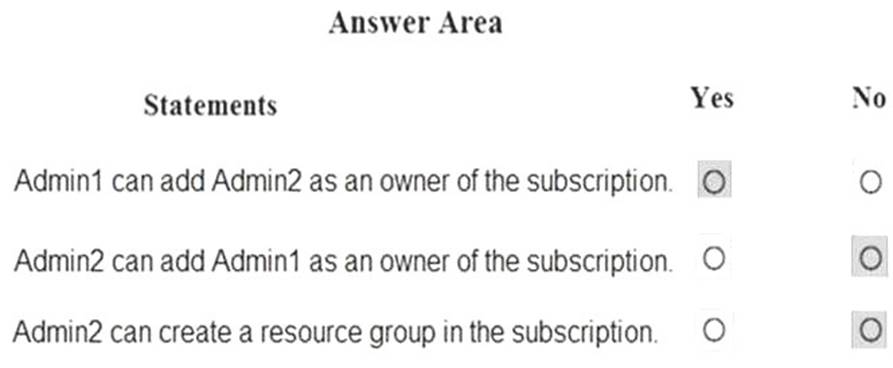
NEW QUESTION 9
You have a virtual network named VNet1 as shown in the exhibit.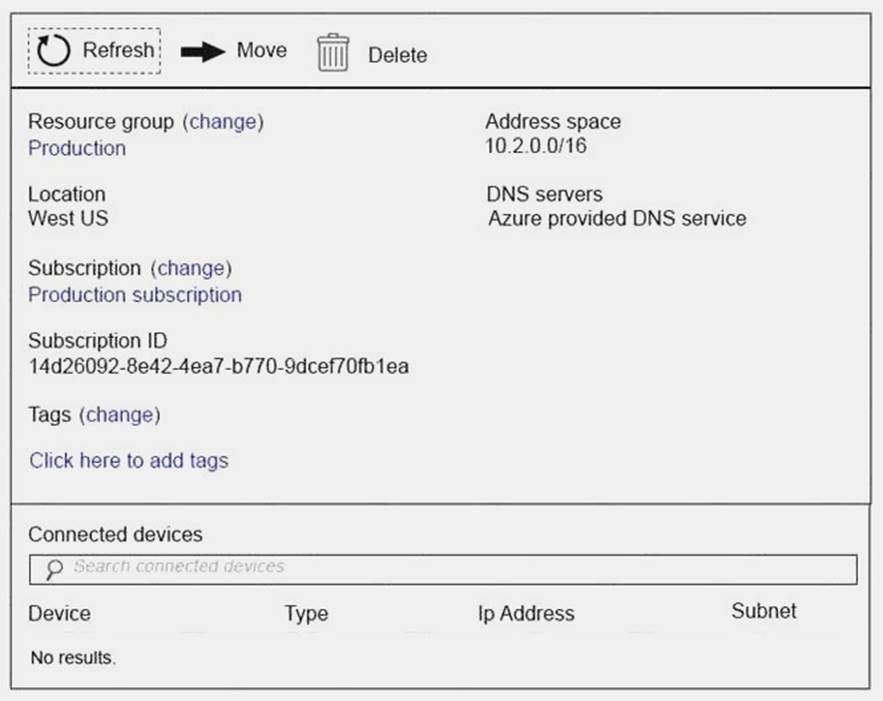
No devices are connected to VNet1.
You plan to peer VNet1 to another virtual network named Vnet2 in the same region. VNet2 has an address space of 10.2.0.0/16.
You need to create the peering. What should you do first?
Answer: A
Explanation: The virtual networks you peer must have non-overlapping IP address spaces. References:
https://docs.microsoft.com/en-us/azure/virtual-network/virtual-network-managepeering# requirements-and-constraints
NEW QUESTION 10
Note: This question is part of a series of questions that present the same scenario. Each question in the series contains a unique solution that might meet the stated goals. Some question sets might have more than one correct solution, while others might not have a correct solution.
After you answer a question in this section, you will NOT be able to return to it. As a result, these questions will not appear in the review screen.
You have an Azure Active Directory (Azure AD) tenant named Adatum and an Azure Subscription named Subscription1. Adatum contains a group named Developers. Subscription1 contains a resource group named Dev.
You need to provide the Developers group with the ability to create Azure logic apps in the Dev resource group.
Solution: On Subscription1, you assign the Logic App Operator role to the Developers group. Does this meet the goal?
Answer: B
Explanation: The Logic App Operator role only lets you read, enable and disable logic app. With it you can view the logic app and run history, and enable/disable. Cannot edit or update the definition.
You would need the Logic App Contributor role. References:
https://docs.microsoft.com/en-us/azure/role-based-access-control/built-in-roles https://docs.microsoft.com/en-us/azure/logic-apps/logic-apps-securing-a-logic-app
NEW QUESTION 11
SIMULATION
Click to expand each objective. To connect to the Azure portal, type https://portal.azure.com in the browser address bar.

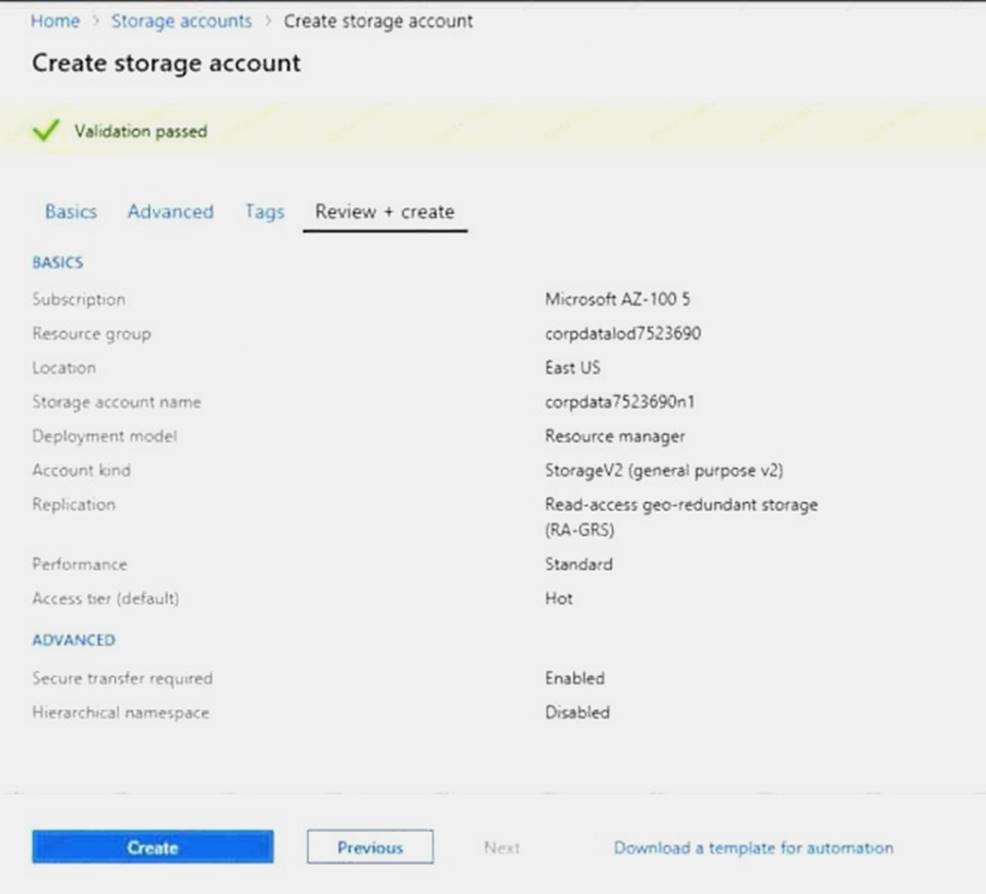
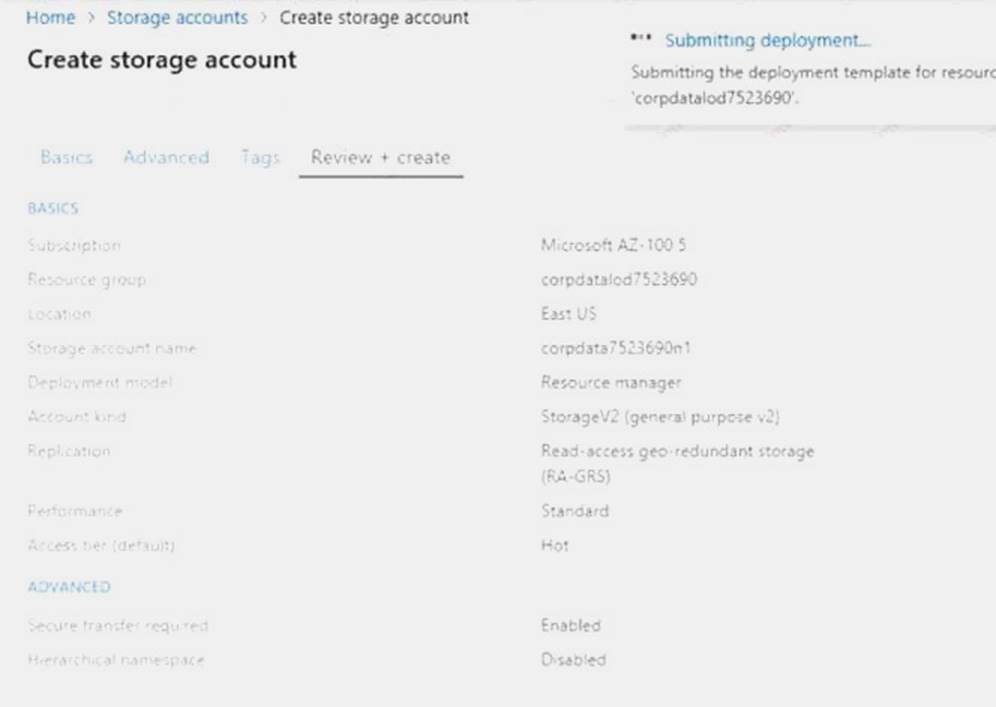

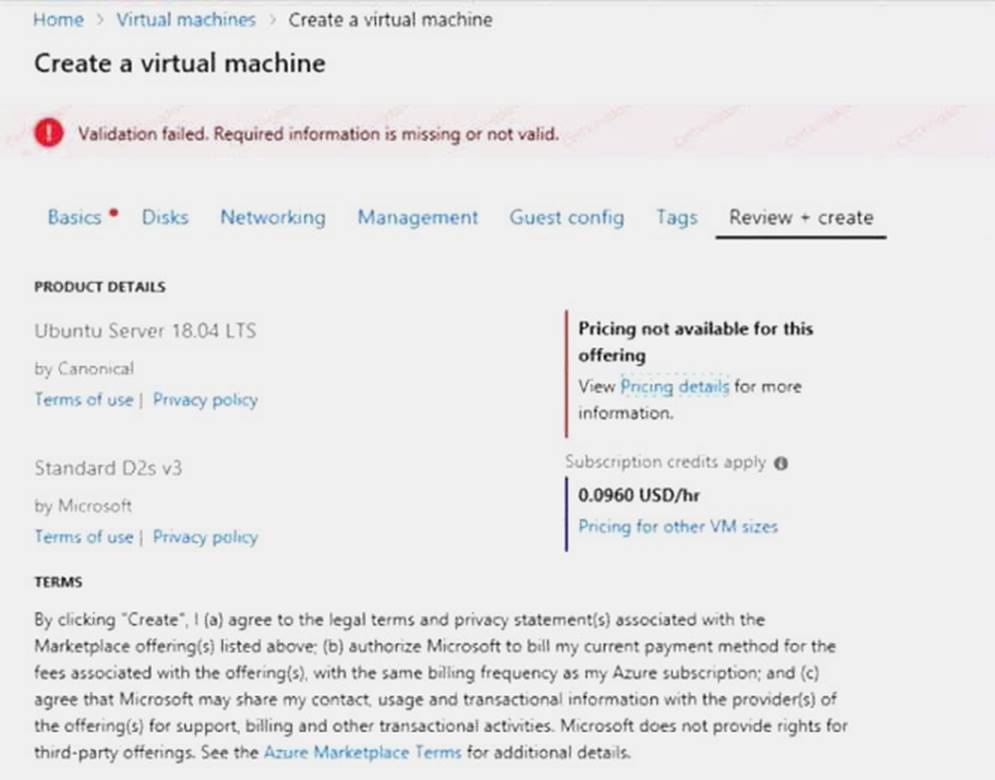
When you are finished performing all the tasks, click the ‘Next’ button.
Note that you cannot return to the lab once you click the ‘Next’ button. Scoring occur in the background while you complete the rest of the exam.
Overview
The following section of the exam is a lab. In this section, you will perform a set of tasks in a live environment. While most functionality will be available to you as it would be in a live environment, some functionality (e.g., copy and paste, ability to navigate to external websites) will not be possible by design. Scoring is based on the outcome of performing the tasks stated in the lab. In other words, it doesn’t matter how you accomplish the task, if you successfully perform it, you will earn credit for that task.
Labs are not timed separately, and this exam may have more than one lab that you must complete. You can use as much time as you would like to complete each lab. But, you should manage your time appropriately to ensure that you are able to complete the lab(s) and all other sections of the exam in the time provided.
Please note that once you submit your work by clicking the Next button within a lab, you will NOT be able to return to the lab.
To start the lab
You may start the lab by clicking the Next button.
You plan to deploy several Azure virtual machines and to connect them to a virtual network named VNET1007.
You need to ensure that future virtual machines in VNET1007 can register their name in an internal DNS zone named corp7523690.com. The zone must NOT be hosted on a virtual machine.
What should you do from Azure Cloud Shell?
To complete this task, start Azure Cloud Shell and select PowerShell(Linux). Click Show Advanced Settings, and then enter corp7523690n1 in the Storage account text box and File1 in the File share text box. Click Create storage, and then complete the task.
Answer:
Explanation: Step 1: New-AzureRMResourceGroup -name MyResourceGroup
Before you create the DNS zone, create a resource group to contain the DNS zone.
Step 2: New-AzureRmDnsZone -Name corp7523690.com -ResourceGroupName MyResourceGroup A DNS zone is created by using the New-AzureRmDnsZone cmdlet. This creates a DNS zone called corp7523690.com in the resource group called MyResourceGroup.
References: https://docs.microsoft.com/en-us/azure/dns/dns-getstarted-powershell
NEW QUESTION 12
From the MFA Server blade, you open the Block/unblock users blade as shown in the exhibit. Block/unblock users
A blocked user will not receive Multi-Factor Authentication requests. Authentication attempts for that user will be automatically denied. A user will remain blocked for 90 days from the time they are blocked. To manually unblock a user, click the “Unblock” action.
What caused AlexW to be blocked?
Answer: D
NEW QUESTION 13
You need to add a deployment slot named staging to an Azure web app named corplod@lab.LabInstance.Idn4. The solution must meet the following requirements:
When new code is deployed to staging, the code must be swapped automatically to the production slot. Azure-related costs must be minimized.
What should you do from the Azure portal?
Answer:
Explanation: Step 1:
Locate and open the corplod@lab.LabInstance.Idn4 web app.
1. In the Azure portal, on the left navigation panel, click Azure Active Directory.
2. In the Azure Active Directory blade, click Enterprise applications. Step 2:
Open your app's resource blade and Choose the Deployment slots option, then click Add Slot.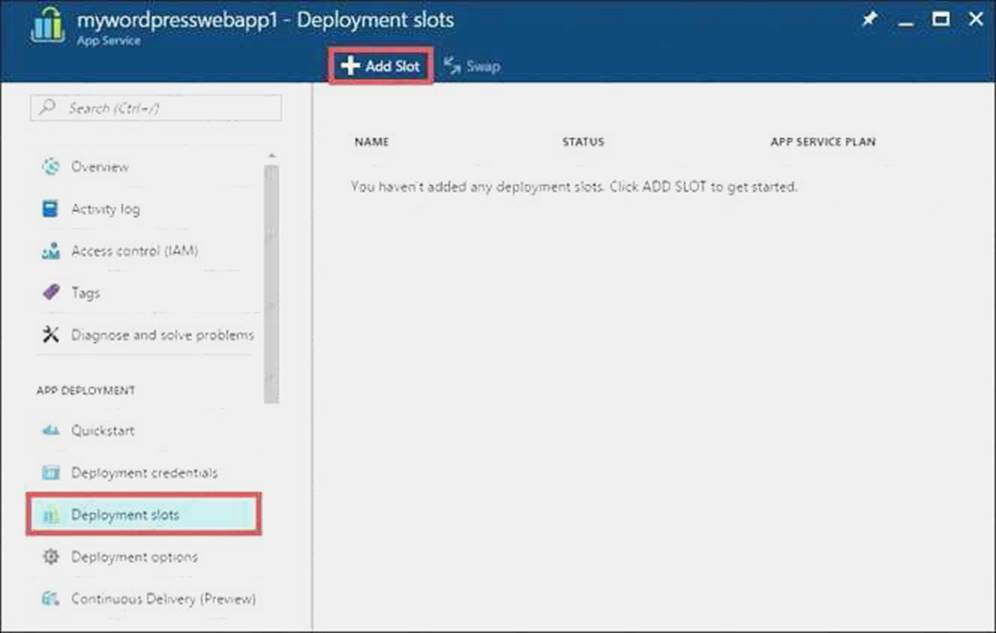
Step 3:
In the Add a slot blade, give the slot a name, and select whether to clone app configuration from another existing deployment slot. Click the check mark to continue.
The first time you add a slot, you only have two choices: clone configuration from the default slot in production or not at all.
References:
https://docs.microsoft.com/en-us/azure/app-service/web-sites-staged-publishing
NEW QUESTION 14
You need to meet the technical requirement for VM4. What should you create and configure?
Answer: B
Explanation: Scenario: Create a workflow to send an email message when the settings of VM4 are modified. You can start an automated logic app workflow when specific events happen in Azure resources or third-party resources. These resources can publish those events to an Azure event grid. In turn, the event grid pushes those events to subscribers that have queues, webhooks, or event hubs as endpoints. As a subscriber, your logic app can wait for those events from the event grid before running automated workflows to perform tasks - without you writing any code.
References:
https://docs.microsoft.com/en-us/azure/event-grid/monitor-virtual-machine-changes-event-gridlogic- app
NEW QUESTION 15
HOT SPOT
You plan to deploy five virtual machines to a virtual network subnet.
Each virtual machine will have a public IP address and a private IP address. Each virtual machine requires the same inbound and outbound security rules.
What is the minimum number of network interfaces and network security groups that you require? To answer, select the appropriate options in the answer area.
NOTE: Each correct selection is worth one point.
Answer:
Explanation: Box 1: 10
One public and one private network interface for each of the five VMs. Box 2: 1
You can associate zero, or one, network security group to each virtual network subnet and network interface in a virtual machine. The same network security group can be associated to as many subnets and network interfaces as you choose.
References:
https://docs.microsoft.com/en-us/azure/virtual-network/security-overview
NEW QUESTION 16
You have an Azure subscription named Subscription1 that has the following providers registered: Authorization
Automation Resources Compute KeyVault Network Storage Billing Web
Subscription1 contains an Azure virtual machine named VM1 that has the following configurations: Private IP address: 10.0.0.4 (dynamic)
Network security group (NSG): NSG1 Public IP address: None
Availability set: AVSet Subnet: 10.0.0.0/24 Managed disks: No Location: East US
You need to record all the successful and failed connection attempts to VM1.
Which three actions should you perform? Each correct answer presents part of the solution.
NOTE: Each correct selection is worth one point.
Answer: ADF
Explanation:
Step 1: (D)
We must have a network watcher enabled in the East US region Step 2: (A+F)
A: NSG flow logging requires the Microsoft.Insights provider, which must be registered.
F: Network security groups (NSG) allow or deny inbound or outbound traffic to a network interface in a VM. The NSG flow log capability allows you to log the source and destination IP address, port, protocol, and whether traffic was allowed or denied by an NSG.
References:
https://docs.microsoft.com/en-us/azure/network-watcher/network-watcher-nsg-flow-logging-portal
NEW QUESTION 17
DRAG DROP
You have an on-premises file server named Server1 that runs Windows Server 2021. You have an Azure subscription that contains an Azure file share.
You deploy an Azure File Sync Storage Sync Service, and you create a sync group. You need to synchronize files from Server1 to Azure.
Which three actions should you perform in sequence? To answer, move the appropriate actions from the list of actions to the answer area and arrange them in the correct order.
Answer:
Explanation: Step 1: Install the Azure File Sync agent on Server1
The Azure File Sync agent is a downloadable package that enables Windows Server to be synced with an Azure file share
Step 2: Register Server1.
Register Windows Server with Storage Sync Service
Registering your Windows Server with a Storage Sync Service establishes a trust relationship between your server (or cluster) and the Storage Sync Service.
Step 3: Add a server endpoint
Create a sync group and a cloud endpoint.
A sync group defines the sync topology for a set of files. Endpoints within a sync group are kept in sync with each other. A sync group must contain one cloud endpoint, which represents an Azure file share and one or more server endpoints. A server endpoint represents a path on registered server. References: https://docs.microsoft.com/en-us/azure/storage/files/storage-sync-files-deploymentguide
NEW QUESTION 18
You plan to support many connections to your company's automatically uses up to five instances when CPU utilization on the instances exceeds 70 percent for 10 minutes. When CPU utilization decreases, the solution must automatically reduce the number of instances.
What should you do from the Azure portal?
Answer:
Explanation: Step 1:
Locate the Homepage App Service plan Step 2:
Click Add a rule, and enter the appropriate fields, such as below, and the click Add. Time aggregation: average
Metric Name: Percentage CPU Operator: Greater than Threshold 70
Duration: 10 minutes Operation: Increase count by Instance count: 4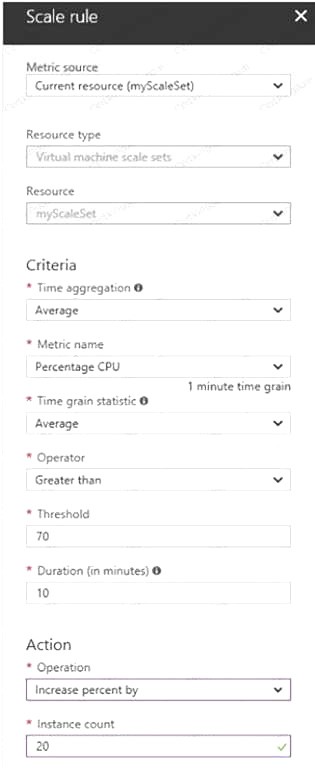
Step 3:
We must add a scale in rule as well. Click Add a rule, and enter the appropriate fields, such as below, then click Add.
Operator: Less than
Threshold 70
Duration: 10 minutes Operation: Decrease count by Instance count: 4 References:
https://docs.microsoft.com/en-us/azure/virtual-machine-scale-sets/virtual-machine-scale-setsautoscale- portal
https://docs.microsoft.com/en-us/azure/monitoring-and-diagnostics/insights-autoscale-bestpractices
NEW QUESTION 19
HOT SPOT
You need to identify the storage requirements for Contoso.
For each of the following statements, select Yes if the statement is true. Otherwise, select No. NOTE: Each correct selection is worth one point.
Answer:
Explanation:
Box 1: Yes
Contoso is moving the existing product blueprint files to Azure Blob storage.
Use unmanaged standard storage for the hard disks of the virtual machines. We use Page Blobs for these.
Box 2: No
Box 3: No
Case Study: 3
Mix Questions
NEW QUESTION 20
You need to define a custom domain name for Azure AD to support the planned infrastructure. Which domain name should you use?
Answer: BD
Explanation: Every Azure AD directory comes with an initial domain name in the form of domainname.onmicrosoft.com. The initial domain name cannot be changed or deleted, but you can add your corporate domain name to Azure AD as well. For example, your organization probably has other domain names used to do business and users who sign in using your corporate domain name. Adding custom domain names to Azure AD allows you to assign user names in the directory that are familiar to your users, such as ‘alice@contoso.com.’ instead of 'alice@domain name.onmicrosoft.com'.
Scenario:
Network Infrastructure: Each office has a local data center that contains all the servers for that office. Each office has a dedicated connection to the Internet.
Humongous Insurance has a single-domain Active Directory forest named humongousinsurance.com Planned Azure AD Infrastructure: The on-premises Active Directory domain will be synchronized to Azure AD.
References: https://docs.microsoft.com/en-us/azure/active-directory/fundamentals/add-customdomain
P.S. Easily pass AZ-102 Exam with 195 Q&As 2passeasy Dumps & pdf Version, Welcome to Download the Newest 2passeasy AZ-102 Dumps: https://www.2passeasy.com/dumps/AZ-102/ (195 New Questions)